中考英语复习课件专题-------主谓一致
文档属性
| 名称 | 中考英语复习课件专题-------主谓一致 | 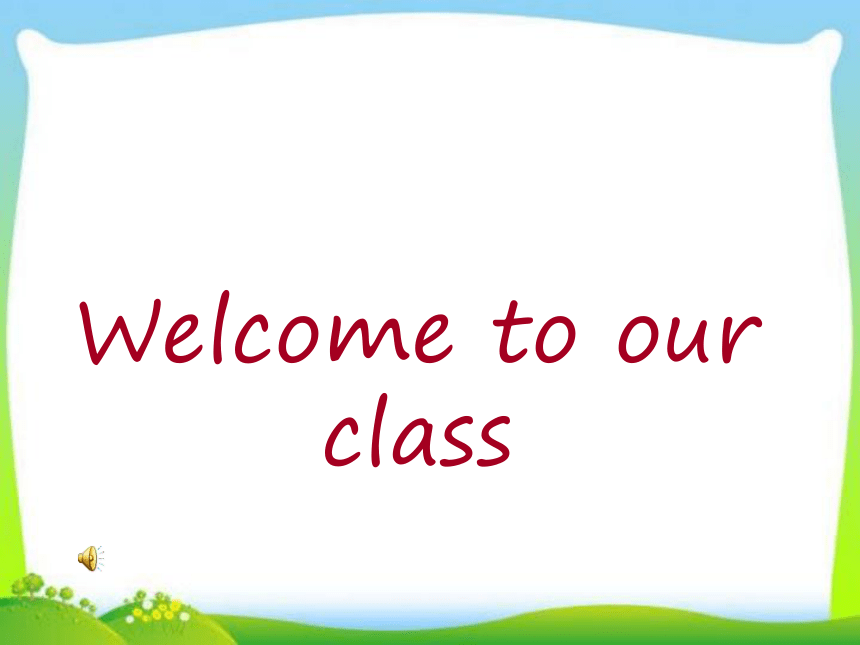 | |
| 格式 | zip | ||
| 文件大小 | 716.6KB | ||
| 资源类型 | 教案 | ||
| 版本资源 | 通用版 | ||
| 科目 | 英语 | ||
| 更新时间 | 2018-05-28 21:31:03 | ||
图片预览


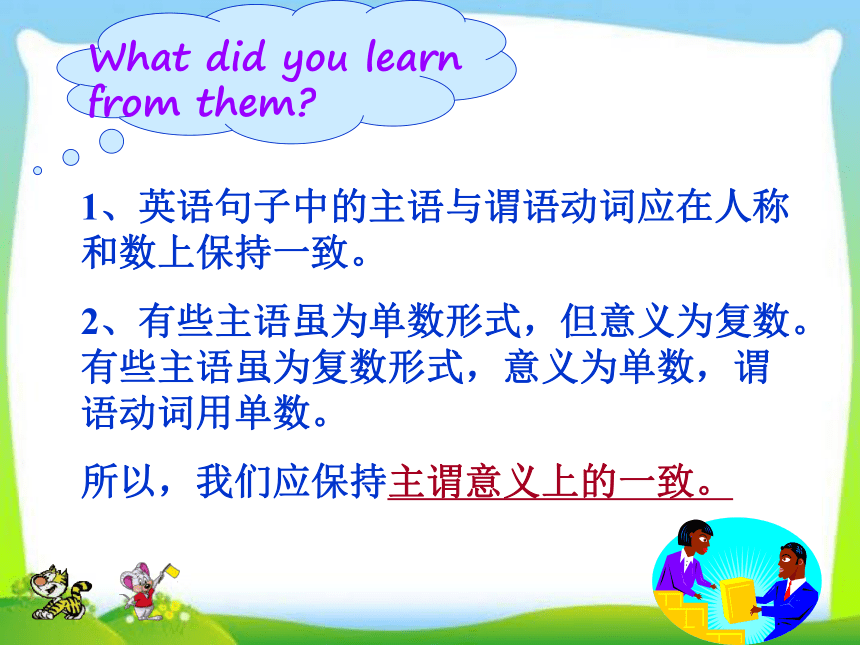

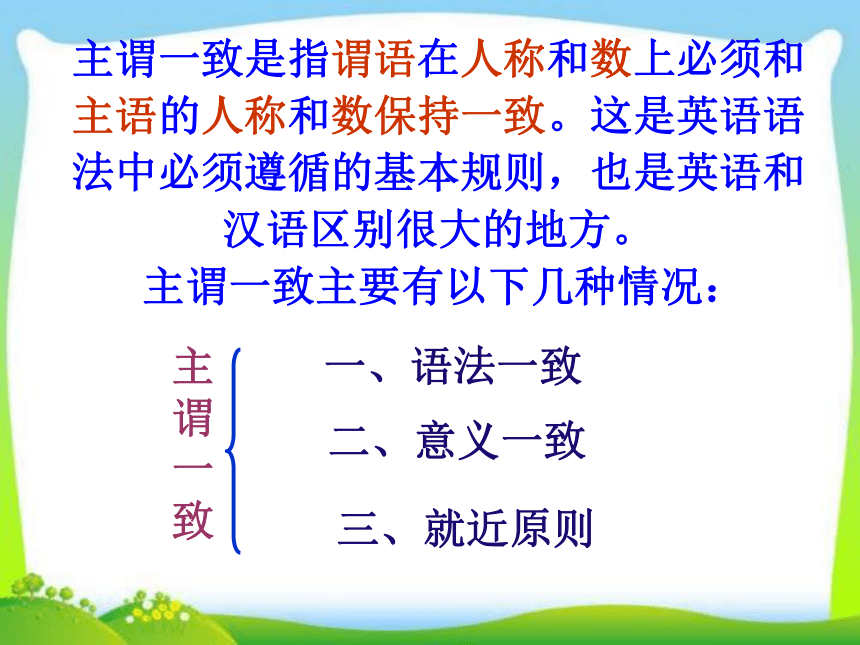
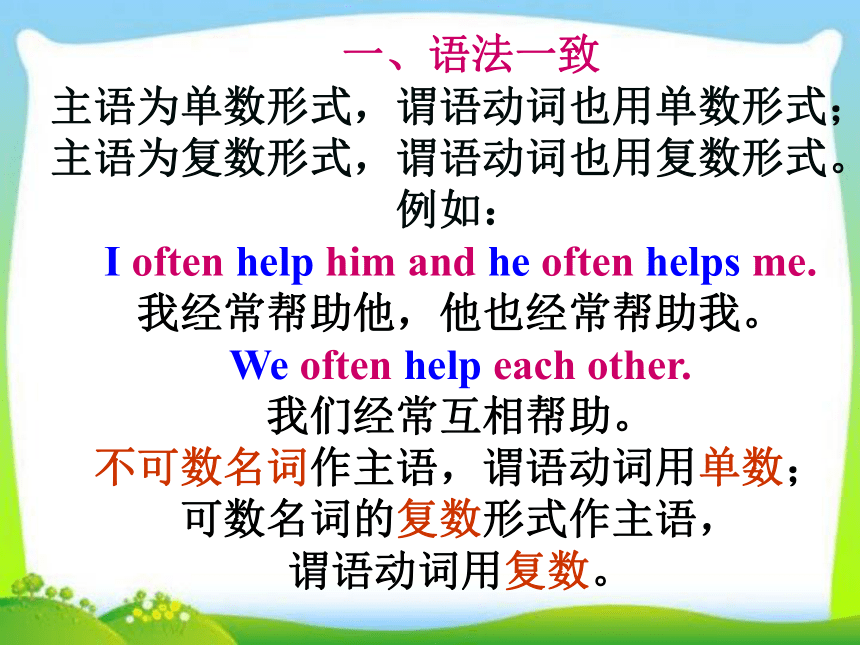

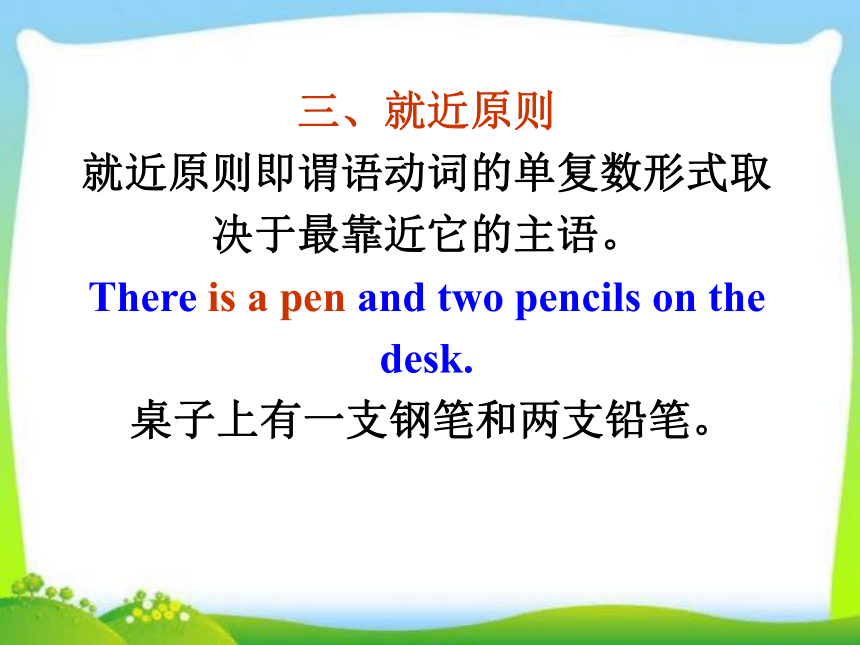
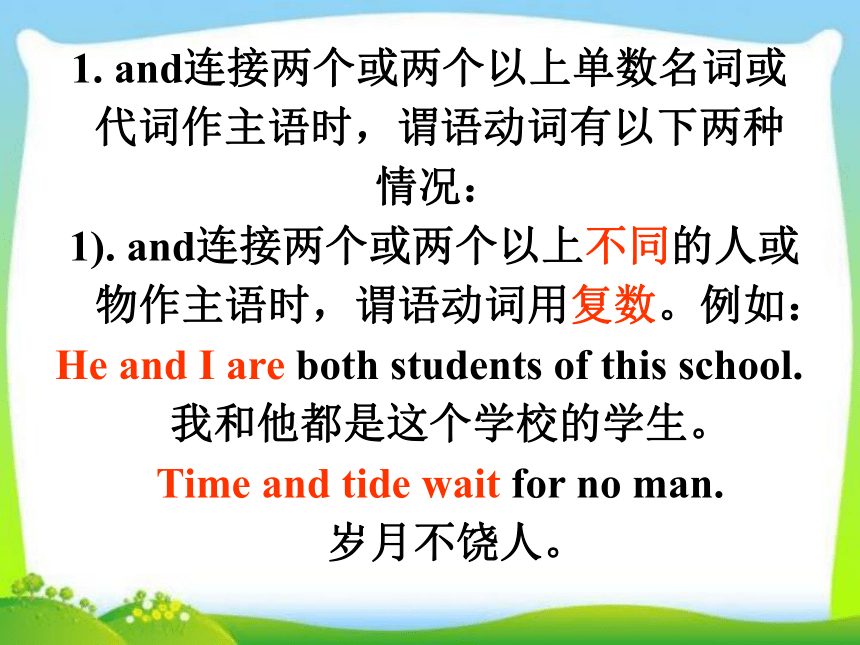

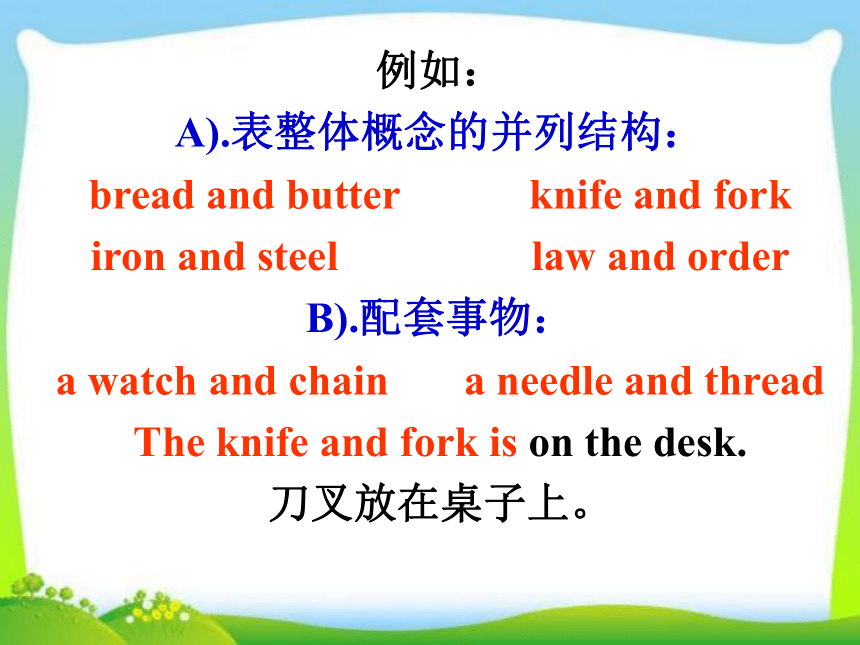
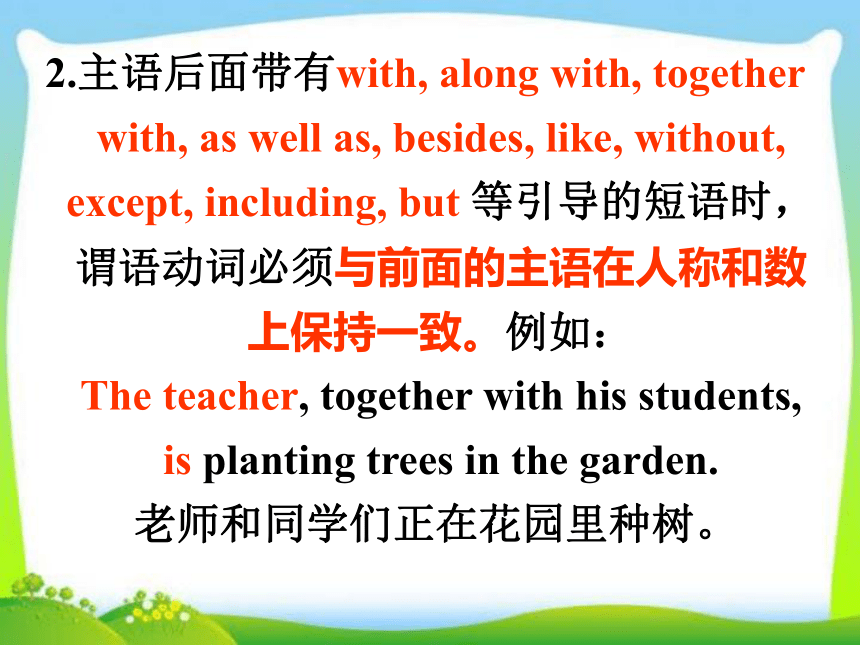
文档简介
(共57张PPT)
Welcome to our class
找出下列句子的错误
1.The police is comimg soon.
2.The sad news make me cry.
3.My shoes is new .
4.The rich is going to be looked after well.
5.This pair of glasses are mine.
6.The first class begin at eight every morning.
Man can’t be perfect.
makes
are
are
are
is
begins
Let’s try.
What did you learn from them
1、英语句子中的主语与谓语动词应在人称和数上保持一致。
2、有些主语虽为单数形式,但意义为复数。有些主语虽为复数形式,意义为单数,谓语动词用单数。
所以,我们应保持主谓意义上的一致。
Subject – verb agreement
主 谓 一 致 性
主谓一致
主谓一致是指谓语在人称和数上必须和主语的人称和数保持一致。这是英语语法中必须遵循的基本规则,也是英语和汉语区别很大的地方。
主谓一致主要有以下几种情况:
二、意义一致
三、就近原则
一、语法一致
一、语法一致
主语为单数形式,谓语动词也用单数形式;
主语为复数形式,谓语动词也用复数形式。
例如:
I often help him and he often helps me.
我经常帮助他,他也经常帮助我。
We often help each other.
我们经常互相帮助。
不可数名词作主语,谓语动词用单数;
可数名词的复数形式作主语,
谓语动词用复数。
二、意义一致
主语形式虽为单数,但意义为复数,谓语动词用复数;
主语形式为复数,而意义为单数,谓语动词用单数。如:
The crowd were surrounding the government official.
人群包围了这位政府官员。
Maths is hard to learn.
数学难学。
三、就近原则
就近原则即谓语动词的单复数形式取决于最靠近它的主语。
There is a pen and two pencils on the desk.
桌子上有一支钢笔和两支铅笔。
and连接两个或两个以上单数名词或
代词作主语时,谓语动词有以下两种
情况:
1). and连接两个或两个以上不同的人或
物作主语时,谓语动词用复数。例如:
He and I are both students of this school.
我和他都是这个学校的学生。
Time and tide wait for no man.
岁月不饶人。
2). 如果连接两个或两个以上的并列结构是指同一个人或物,或指同一概念时,谓语动词用单数,这时and后面的名词前不加冠词。
例如:
A).表整体概念的并列结构:
bread and butter knife and fork
iron and steel law and order
B).配套事物:
a watch and chain a needle and thread
The knife and fork is on the desk.
刀叉放在桌子上。
2.主语后面带有with, along with, together with, as well as, besides, like, without, except, including, but 等引导的短语时,谓语动词必须与前面的主语在人称和数上保持一致。例如:
The teacher, together with his students, is planting trees in the garden.
老师和同学们正在花园里种树。
3.如果主语是不定式,动词-ing形式或主语从句时,谓语动词用单数。
What he is doing seems very important.
他正在做什么看起来很重要。
Serving the people is my great happiness.
为人民服务是我最大的幸福。
4. 用连接的并列主语被each, every 或no修饰时,谓语动词用单数。
Every boy and every girl in the
class is diligent.
班里的每个男孩女孩都很用功。
. Every one of one of each of either of +复数名词作主语,谓语用单数。
Each of the students has a book.
. One of your books is new.
5. each of + 复数代词, 谓语动用单数。
复数代词+ each, 谓语动词用复数。
如:
Each of us has something to say.
We each have something to say.
我们每个人都有些话要说。
6. 不定代词all, more, some, any, none等
作主语时,谓语动词视情况而定。谓语动词可用单数,也可用复数;但当它指代不可数名词时看作单数,谓语动词用单数。
All the apples are rotten.
所有的苹果都烂了。
All the apple is rotten.
整个苹果都烂了。
None of us are /is perfect. 人无完人。
None of the money is left.
一点钱也没剩下。
7. 复合不定代词作主语时,谓语动词
用单数。
Someone is calling you.
有人叫你。
Nothing is found in the room.
在屋里找不到什么东西。
8. 名词如trousers, scissors, clothes, goods, glasses 等作主语时,谓语动词必须用复数;如:
The scissors are sharp.
而形复义单的名词如news;以-ics结尾的学科名称如physics, politics, 国名如the United States; 报纸名如the New Times; 书名如Great Expectations(《远大前程》);以及the United Nations作主语时,谓语动词用单数。
如:
No news is good news.
Great Expectations was written by
Charles Dickens in 1860.
9. 集体名词作主语,谓语动词可用单数,
也可用复数,主要由句子的意思决定。若指一个整体,谓语动词用单数形式;但若指其成员时,谓语动词用复数形式。这类名词有people, family, class, population, crowd, team, ground等。
例如:The family is very big.
Their family are watching TV now.
Chinese people is a hardworking people.
people here are very kind.
10. 有些名词单复数形式相同,作主语时,谓语动词由上下文决定。这类名词有means, deer, sheep, Chinese, Japanese, fish等。如:
Not every means is useful.
并非每种方法都有效。
Not all means are useful.
并非所有的方法都有效。
11. 表示一类人的 “the +形容词(分词)”作主语时,谓语动词用复数。
The sick in the accident have been taken to the hospital.
The lost have been found.
12. 表示时间、金钱、距离、度量等名词作主语时,不管单复数形式,其谓语动词用单数。如:
Thirty years is not a long time.
30年的时间并不长。
Two hours is enough for me to finish the work.
两个小时对我来说完成这项工作足够了。
13. the rest of, half of, majority of, part of, a lot of, lots of, one of, a number of, a plenty of, percent of 以及分数词等作主语时,谓语动词的单复数取决于后面名词的数,即就近原则。如:
A part of the students have arrived.
部分学生已到了。
A part of the apple has been eaten by the mouse.
这个苹果的一部分被老鼠吃了。
14. 在表存在的there be 句式中,主语是两个或多个并列名词(短语),be的形式与最近的一个名词(短语)保持一致。
There is a pen, two pencils and several
books on the desk.
=There are two pencils, a pen and several books on the desk.
=There are several books, a pen and two pencils on the desk.
15. 由here, there等引导的倒装句中,若主语不止一个时,谓语动词与最近的主语保持一致。如:
Here comes the bus.
Here is a pen and two books for you.
16. 用连词 or, either…or, neither…nor,
not only…but also等连接并列主语时,
谓语动词应与最近的主语保持一致。如:
Neither you nor I am wrong.
Neither I nor you are wrong.
Not only the students but also the teacher enjoys listening to the music.
Not only the teacher but also the students enjoy listening to the music.
1. 由and连接的并列成分指的是一个人的双重身份时谓语动词为单数,如果指不同的人或物时谓语动词用复数。 The worker and writer is from Wuhan. (那个工人兼作家…)
The worker and the writer are from Beijing. (那位工人和那位作家)
谓语应该跟主语一致还是跟表语一致
We Chinese ____ a hard-working people.
A. is B. are C. is being D. are being
此题应选B。这里应注意的是:我们通常说的是主谓一致(即谓语与主语保持一致),而不是表谓一致(即不是谓语与表语一致),本题意为:我们中国人是一个勤劳的民族。
注意以下类似例子:
These two dictionaries are a present for my best friend Jim.
The planets were the object of his study.
The most important thing I need is books.
The best part of the meal is the coffee and cookies.
When and where to build the new factory______ yet. A. is not decided B. are not decided C. has not decided D. have not decided
析: 当when和where加不定式指的是同一件事时,谓语动词用单数。
A
every并列使用时,动词取单数。
Every boy and every girl ______ that each day and each hour brings ______ duty.
A. know, their B. knows, their
C. knows, its D. know, its
E-mail, as well as telephones, ____ an important part in daily communication.
A. is playing B. have played
C. are playing D. play
A library with five thousand books ____ to the nation as a gift.
A. is offered B. has offered
C. are offered D. have offered
3. Not only I but also Jane and Mary ____ tired of having one examination after another.
A. is B. are C. am D. be
4. Not the teacher, but the students ____ looking forward to seeing the film.
A. is B. are C. am D. be
5. A woman with some children ______ soon.
A. is coming B. are coming
C. has come D. have come
6. No one except my parents ____ anything about this。
A. know B. knows
C. is known D. are known
7.The teacher as well as the students ______ the book already.
A. has read B. have read
C. are reading D. is reading
8.All but (除了)one ____ in the accident.
A. was killed B. were killed
C. will be killed D. are killed
9. The number of people invited ___fifty, but a number of them ___ absent for different reasons.
A. were; was B. was; was C. was; were D. were; were
10. ____ of the land in that district ____ covered with trees and grass.
A. Two fifth; is B. Two fifth; are
C. Two fifths; is D. Two fifths; are
1.Our class are going to hike next week
Our class are big and clean .
2.A speaker and writer does exercise every day.
A speaker and a writer does exercise every day.
Do you know the differences
3.A number of Chinese are learning English.
The number of the students are forty.
哪一句表达正确?
给句子填上is/am/are
1.There _____some milk and some bottles on the table.
2.Neither Jim nor Mary ______ right.
3.Either you or I_______going to work there.
4.Not only the students but also their teacher ____happy.
5.There ______some sheep and a child over there.
is
is
am
is
are
There be _ A _ and _ B _
Either _A_ or_ B _
Neither_A_nor_B_
Not only_A_but also_B_
动词
Thinking makes you clever
就近原则
1.Behind the house _______(be)some trees.
2.Every student and every teacher _______(come)
to school on time in the morning.
3.No man and no woman ______(like) these shoes.
4.He or she ______(have) gone there.
5.What he said________(sound) reasonable.
6. “I”____(be) the ninth letter.
Can you work them out
are
comes
likes
has
sounds
is
True gold fears not the fire.
找出各句中的错误
1.A number of students has seen the film.
2.This kind of apples taste very good.
3.Not only my classroom but also my teacher are
fond of sports.
4.The Greens has returned to England.
5.Those who only thinks of themselves can never be
happy.
6.When each person come in ,they must show their
tickets .
have
tastes
is
have
think
comes
Think carefully
7.Ten thousand pounds are a lot of money.
8.Mary likes many other girls likes dancing .
9.We are Chinese . You two are German.
10.The singer and dancer look very young .
11.Fish and chips are my favourite.
12.Nobody but the twin sisters know the secret.
I can make it
is
like
Germans
looks
is
knows
Multiple choice:
1. On the wall______ two large portraits.
A. hangs B. hang C. hanged D. hanging
2. “News of victories _____ pouring in as our army advances,” the company commander said.
A. keep B. kept C. keeps D. have kept
3. There _____ a lot of milk in the bottle.
A. are B. is C. were D. has
4. Zhang’s family ____ rather big, with
twelve people in all.
A. is B. are
C. being D. was
5. Nobody but Jane ____ the secret.
A. know B. knows
C. have known D. is known
6. All but one _____ here just now.
A. is B. was C. has been D. were
7. When and where to build the new factory _____ yet.
A. is not decided B. are not decided
C. has not decided D. have not decided
8. A library with five thousand books____ to the nation as a gift.
A. is offered B. has offered
C. are offered D. have offered
1. The country life he was used to ______ greatly since 1992.
A. change
B. has changed
C. changing
D. have changed
2. Nowadays, a large number of
women, especially those from the countryside, _________ in the clothing industry.
A.is working
B.works
C.work
D.worked
3. A poet and artist ________ coming to speak to us about Chinese literature and painting tomorrow afternoon. A. is
B. are
C. was
D. were
4. A survey of the opinions of experts ______that three hours of outdoor exercise a week ____ good for
one’s health.
A. show; are
B. shows; is
C. show; is
D. shows; are
Not only I but Jane and Mary _____ tired of having one examination after another.
A. is B. are C. am D. be
A library with five thousand books ____ to the nation as a gift.
A. is offered B. has offered
C. are offered D. have offered
1、主谓倒装句,动词应与其——的主语一致。
2、“一段———”,“一段————”,“一些————”作
主语时,动词用单数。
3、几分之几作主语时,动词由其后面的————或代词
决定。但one and a half 作主语时,动词用单数。
4、定语从句的动词与其前面的————一致。
5、动名词,动词不定式作主语时,动词用———。
6、当主语后with ,together with,like ,but,except,as well as
等介词词组时,动词依其——的主语而定。
后
时间
距离
金钱
前
名词
先行词
单数
Welcome to our class
找出下列句子的错误
1.The police is comimg soon.
2.The sad news make me cry.
3.My shoes is new .
4.The rich is going to be looked after well.
5.This pair of glasses are mine.
6.The first class begin at eight every morning.
Man can’t be perfect.
makes
are
are
are
is
begins
Let’s try.
What did you learn from them
1、英语句子中的主语与谓语动词应在人称和数上保持一致。
2、有些主语虽为单数形式,但意义为复数。有些主语虽为复数形式,意义为单数,谓语动词用单数。
所以,我们应保持主谓意义上的一致。
Subject – verb agreement
主 谓 一 致 性
主谓一致
主谓一致是指谓语在人称和数上必须和主语的人称和数保持一致。这是英语语法中必须遵循的基本规则,也是英语和汉语区别很大的地方。
主谓一致主要有以下几种情况:
二、意义一致
三、就近原则
一、语法一致
一、语法一致
主语为单数形式,谓语动词也用单数形式;
主语为复数形式,谓语动词也用复数形式。
例如:
I often help him and he often helps me.
我经常帮助他,他也经常帮助我。
We often help each other.
我们经常互相帮助。
不可数名词作主语,谓语动词用单数;
可数名词的复数形式作主语,
谓语动词用复数。
二、意义一致
主语形式虽为单数,但意义为复数,谓语动词用复数;
主语形式为复数,而意义为单数,谓语动词用单数。如:
The crowd were surrounding the government official.
人群包围了这位政府官员。
Maths is hard to learn.
数学难学。
三、就近原则
就近原则即谓语动词的单复数形式取决于最靠近它的主语。
There is a pen and two pencils on the desk.
桌子上有一支钢笔和两支铅笔。
and连接两个或两个以上单数名词或
代词作主语时,谓语动词有以下两种
情况:
1). and连接两个或两个以上不同的人或
物作主语时,谓语动词用复数。例如:
He and I are both students of this school.
我和他都是这个学校的学生。
Time and tide wait for no man.
岁月不饶人。
2). 如果连接两个或两个以上的并列结构是指同一个人或物,或指同一概念时,谓语动词用单数,这时and后面的名词前不加冠词。
例如:
A).表整体概念的并列结构:
bread and butter knife and fork
iron and steel law and order
B).配套事物:
a watch and chain a needle and thread
The knife and fork is on the desk.
刀叉放在桌子上。
2.主语后面带有with, along with, together with, as well as, besides, like, without, except, including, but 等引导的短语时,谓语动词必须与前面的主语在人称和数上保持一致。例如:
The teacher, together with his students, is planting trees in the garden.
老师和同学们正在花园里种树。
3.如果主语是不定式,动词-ing形式或主语从句时,谓语动词用单数。
What he is doing seems very important.
他正在做什么看起来很重要。
Serving the people is my great happiness.
为人民服务是我最大的幸福。
4. 用连接的并列主语被each, every 或no修饰时,谓语动词用单数。
Every boy and every girl in the
class is diligent.
班里的每个男孩女孩都很用功。
. Every one of one of each of either of +复数名词作主语,谓语用单数。
Each of the students has a book.
. One of your books is new.
5. each of + 复数代词, 谓语动用单数。
复数代词+ each, 谓语动词用复数。
如:
Each of us has something to say.
We each have something to say.
我们每个人都有些话要说。
6. 不定代词all, more, some, any, none等
作主语时,谓语动词视情况而定。谓语动词可用单数,也可用复数;但当它指代不可数名词时看作单数,谓语动词用单数。
All the apples are rotten.
所有的苹果都烂了。
All the apple is rotten.
整个苹果都烂了。
None of us are /is perfect. 人无完人。
None of the money is left.
一点钱也没剩下。
7. 复合不定代词作主语时,谓语动词
用单数。
Someone is calling you.
有人叫你。
Nothing is found in the room.
在屋里找不到什么东西。
8. 名词如trousers, scissors, clothes, goods, glasses 等作主语时,谓语动词必须用复数;如:
The scissors are sharp.
而形复义单的名词如news;以-ics结尾的学科名称如physics, politics, 国名如the United States; 报纸名如the New Times; 书名如Great Expectations(《远大前程》);以及the United Nations作主语时,谓语动词用单数。
如:
No news is good news.
Great Expectations was written by
Charles Dickens in 1860.
9. 集体名词作主语,谓语动词可用单数,
也可用复数,主要由句子的意思决定。若指一个整体,谓语动词用单数形式;但若指其成员时,谓语动词用复数形式。这类名词有people, family, class, population, crowd, team, ground等。
例如:The family is very big.
Their family are watching TV now.
Chinese people is a hardworking people.
people here are very kind.
10. 有些名词单复数形式相同,作主语时,谓语动词由上下文决定。这类名词有means, deer, sheep, Chinese, Japanese, fish等。如:
Not every means is useful.
并非每种方法都有效。
Not all means are useful.
并非所有的方法都有效。
11. 表示一类人的 “the +形容词(分词)”作主语时,谓语动词用复数。
The sick in the accident have been taken to the hospital.
The lost have been found.
12. 表示时间、金钱、距离、度量等名词作主语时,不管单复数形式,其谓语动词用单数。如:
Thirty years is not a long time.
30年的时间并不长。
Two hours is enough for me to finish the work.
两个小时对我来说完成这项工作足够了。
13. the rest of, half of, majority of, part of, a lot of, lots of, one of, a number of, a plenty of, percent of 以及分数词等作主语时,谓语动词的单复数取决于后面名词的数,即就近原则。如:
A part of the students have arrived.
部分学生已到了。
A part of the apple has been eaten by the mouse.
这个苹果的一部分被老鼠吃了。
14. 在表存在的there be 句式中,主语是两个或多个并列名词(短语),be的形式与最近的一个名词(短语)保持一致。
There is a pen, two pencils and several
books on the desk.
=There are two pencils, a pen and several books on the desk.
=There are several books, a pen and two pencils on the desk.
15. 由here, there等引导的倒装句中,若主语不止一个时,谓语动词与最近的主语保持一致。如:
Here comes the bus.
Here is a pen and two books for you.
16. 用连词 or, either…or, neither…nor,
not only…but also等连接并列主语时,
谓语动词应与最近的主语保持一致。如:
Neither you nor I am wrong.
Neither I nor you are wrong.
Not only the students but also the teacher enjoys listening to the music.
Not only the teacher but also the students enjoy listening to the music.
1. 由and连接的并列成分指的是一个人的双重身份时谓语动词为单数,如果指不同的人或物时谓语动词用复数。 The worker and writer is from Wuhan. (那个工人兼作家…)
The worker and the writer are from Beijing. (那位工人和那位作家)
谓语应该跟主语一致还是跟表语一致
We Chinese ____ a hard-working people.
A. is B. are C. is being D. are being
此题应选B。这里应注意的是:我们通常说的是主谓一致(即谓语与主语保持一致),而不是表谓一致(即不是谓语与表语一致),本题意为:我们中国人是一个勤劳的民族。
注意以下类似例子:
These two dictionaries are a present for my best friend Jim.
The planets were the object of his study.
The most important thing I need is books.
The best part of the meal is the coffee and cookies.
When and where to build the new factory______ yet. A. is not decided B. are not decided C. has not decided D. have not decided
析: 当when和where加不定式指的是同一件事时,谓语动词用单数。
A
every并列使用时,动词取单数。
Every boy and every girl ______ that each day and each hour brings ______ duty.
A. know, their B. knows, their
C. knows, its D. know, its
E-mail, as well as telephones, ____ an important part in daily communication.
A. is playing B. have played
C. are playing D. play
A library with five thousand books ____ to the nation as a gift.
A. is offered B. has offered
C. are offered D. have offered
3. Not only I but also Jane and Mary ____ tired of having one examination after another.
A. is B. are C. am D. be
4. Not the teacher, but the students ____ looking forward to seeing the film.
A. is B. are C. am D. be
5. A woman with some children ______ soon.
A. is coming B. are coming
C. has come D. have come
6. No one except my parents ____ anything about this。
A. know B. knows
C. is known D. are known
7.The teacher as well as the students ______ the book already.
A. has read B. have read
C. are reading D. is reading
8.All but (除了)one ____ in the accident.
A. was killed B. were killed
C. will be killed D. are killed
9. The number of people invited ___fifty, but a number of them ___ absent for different reasons.
A. were; was B. was; was C. was; were D. were; were
10. ____ of the land in that district ____ covered with trees and grass.
A. Two fifth; is B. Two fifth; are
C. Two fifths; is D. Two fifths; are
1.Our class are going to hike next week
Our class are big and clean .
2.A speaker and writer does exercise every day.
A speaker and a writer does exercise every day.
Do you know the differences
3.A number of Chinese are learning English.
The number of the students are forty.
哪一句表达正确?
给句子填上is/am/are
1.There _____some milk and some bottles on the table.
2.Neither Jim nor Mary ______ right.
3.Either you or I_______going to work there.
4.Not only the students but also their teacher ____happy.
5.There ______some sheep and a child over there.
is
is
am
is
are
There be _ A _ and _ B _
Either _A_ or_ B _
Neither_A_nor_B_
Not only_A_but also_B_
动词
Thinking makes you clever
就近原则
1.Behind the house _______(be)some trees.
2.Every student and every teacher _______(come)
to school on time in the morning.
3.No man and no woman ______(like) these shoes.
4.He or she ______(have) gone there.
5.What he said________(sound) reasonable.
6. “I”____(be) the ninth letter.
Can you work them out
are
comes
likes
has
sounds
is
True gold fears not the fire.
找出各句中的错误
1.A number of students has seen the film.
2.This kind of apples taste very good.
3.Not only my classroom but also my teacher are
fond of sports.
4.The Greens has returned to England.
5.Those who only thinks of themselves can never be
happy.
6.When each person come in ,they must show their
tickets .
have
tastes
is
have
think
comes
Think carefully
7.Ten thousand pounds are a lot of money.
8.Mary likes many other girls likes dancing .
9.We are Chinese . You two are German.
10.The singer and dancer look very young .
11.Fish and chips are my favourite.
12.Nobody but the twin sisters know the secret.
I can make it
is
like
Germans
looks
is
knows
Multiple choice:
1. On the wall______ two large portraits.
A. hangs B. hang C. hanged D. hanging
2. “News of victories _____ pouring in as our army advances,” the company commander said.
A. keep B. kept C. keeps D. have kept
3. There _____ a lot of milk in the bottle.
A. are B. is C. were D. has
4. Zhang’s family ____ rather big, with
twelve people in all.
A. is B. are
C. being D. was
5. Nobody but Jane ____ the secret.
A. know B. knows
C. have known D. is known
6. All but one _____ here just now.
A. is B. was C. has been D. were
7. When and where to build the new factory _____ yet.
A. is not decided B. are not decided
C. has not decided D. have not decided
8. A library with five thousand books____ to the nation as a gift.
A. is offered B. has offered
C. are offered D. have offered
1. The country life he was used to ______ greatly since 1992.
A. change
B. has changed
C. changing
D. have changed
2. Nowadays, a large number of
women, especially those from the countryside, _________ in the clothing industry.
A.is working
B.works
C.work
D.worked
3. A poet and artist ________ coming to speak to us about Chinese literature and painting tomorrow afternoon. A. is
B. are
C. was
D. were
4. A survey of the opinions of experts ______that three hours of outdoor exercise a week ____ good for
one’s health.
A. show; are
B. shows; is
C. show; is
D. shows; are
Not only I but Jane and Mary _____ tired of having one examination after another.
A. is B. are C. am D. be
A library with five thousand books ____ to the nation as a gift.
A. is offered B. has offered
C. are offered D. have offered
1、主谓倒装句,动词应与其——的主语一致。
2、“一段———”,“一段————”,“一些————”作
主语时,动词用单数。
3、几分之几作主语时,动词由其后面的————或代词
决定。但one and a half 作主语时,动词用单数。
4、定语从句的动词与其前面的————一致。
5、动名词,动词不定式作主语时,动词用———。
6、当主语后with ,together with,like ,but,except,as well as
等介词词组时,动词依其——的主语而定。
后
时间
距离
金钱
前
名词
先行词
单数
同课章节目录
- 词法
- 名词
- 动词和动词短语
- 动词语态
- 动词时态
- 助动词和情态动词
- 非谓语动词
- 冠词
- 代词
- 数词和量词
- 形容词副词及其比较等级
- 介词和介词短语
- 连词和感叹词
- 构词法
- 相似、相近词比较
- 句法
- 陈述句
- 一般疑问句和否定疑问句
- 特殊疑问句及选择疑问句
- 反意疑问句
- 存在句(There be句型)
- 宾语从句
- 定语从句
- 状语从句
- 主谓一致问题
- 简单句
- 并列句
- 复合句
- 主谓一致
- 主、表语从句
- 名词性从句
- 直接引语和间接引语
- 虚拟语气
- 感叹句
- 强调句
- 倒装句
- 祈使句
- 句子的成分
- 句子的分类
- 题型专区
- 单项选择部分
- 易错题
- 完形填空
- 阅读理解
- 词汇练习
- 听说训练
- 句型转换
- 补全对话
- 短文改错
- 翻译
- 书面表达
- 任务型阅读
- 语法填空
- 其他资料
